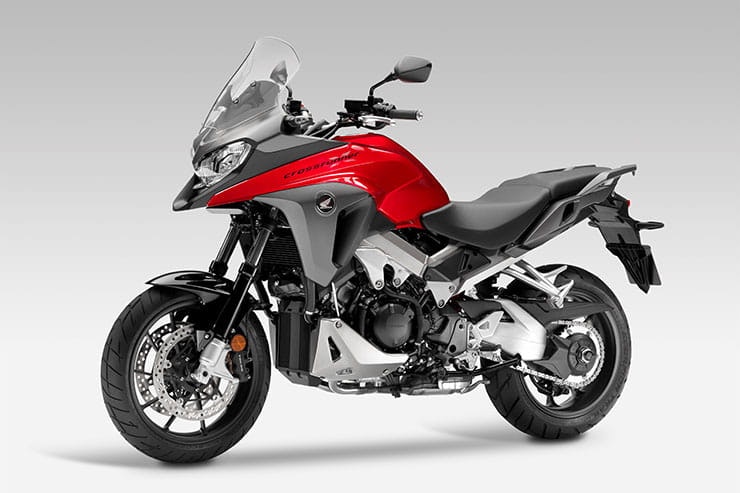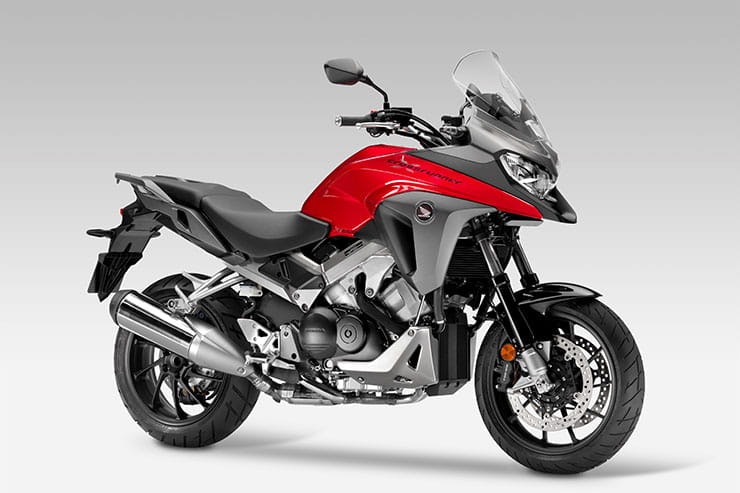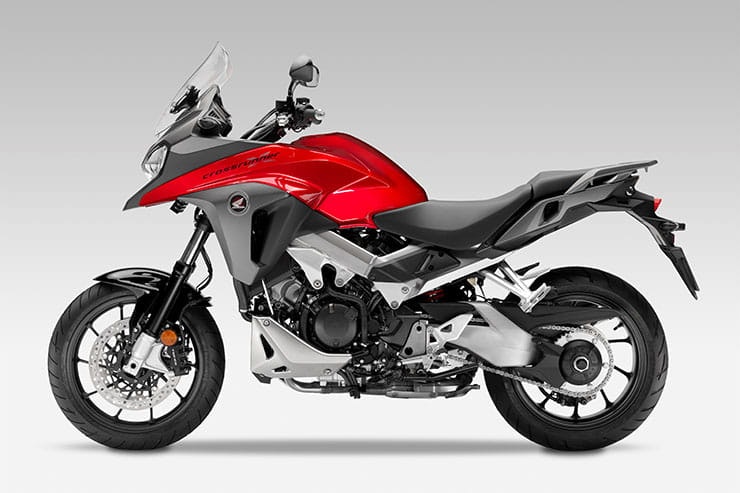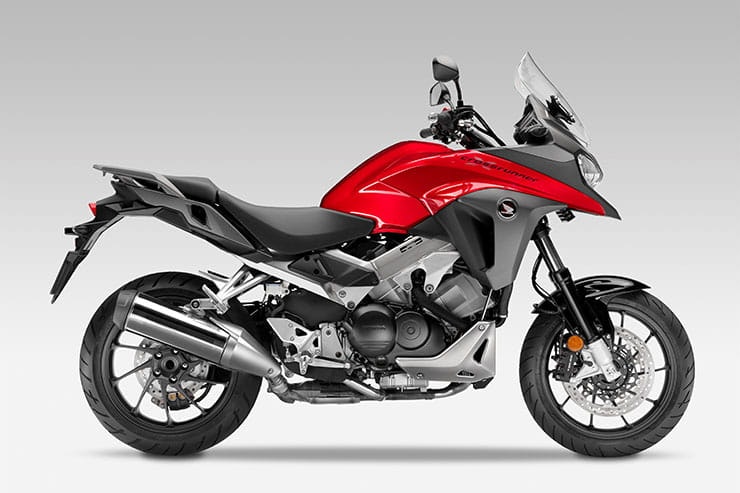Honda VFR800X Crossrunner (2015-2021): Review & Buying Guide
By Jon Urry
Massively experienced road tester
14.11.2023
Price: £5000-£9000 | Power: 104bhp | Weight: 242kg | Overall BikeSocial Rating: 4/5
The Honda VFR800X Crossrunner is a bike that should have sold very well but due to its quirky styling, was generally overlooked. Those that were prepared to give this V4-powered sports-adventure bike a shot very quickly found themselves won over by the Crossrunner’s all-round ability and surprising charm. A really good do-it-all that has excellent build quality, unquestioned reliability and a fairly healthy dose of V4 performance, the Crossrunner makes for a superb town-hauler, solo tourer or daily commuter. Yes, it undeniably looks a bit odd, but get over this small obstacle and you will discover it is a remarkably adept machine that is very well priced in the used market. A bike you buy and keep as your go-to choice for slogging out hard miles for the next decade or more...
Honda VFR800X Crossrunner (2015-2021) Price
With an initial price tag of over £10,000, and slightly challenging looks, the Crossrunner struggled to make much of an impression when new. Especially when you consider bikes such as the Kawasaki Versys 1000 and later the Yamaha Tracer 900 were on the scene. Dealers did cut prices in response, as well as adding luggage for free and sometimes an Akrapovič exhaust, but despite all this the Crossrunner never saw sales anything like the VFR recorded in its heyday. There again, with Honda’s own extremely popular NC range also rivalling it, what did the firm expect? Nowadays you can buy a 2015 second-generation Crossrunner (the original 2011-2014 bike isn’t worth picking over it) for close to £5000 in a private sale with dealers asking for between £500 and £1000 more depending on condition and mileage. Most bikes have luggage fitted, which certainly makes them seem good value for money. Updated (slightly...) 2017 bikes start at £6000 with £9000 the absolute top-price for a 2021 model with low mileage and full luggage.
Flexible engine
Surprisingly charming to ride
Tempting price tag
Bland looks
TC isn’t the best
Expensive major service
Engine and Performance
The heart of the Crossrunner is the latest-generation VFR800 engine, which is quite substantially updated from the older Crossrunner model (2011-2014) which ran the older-generation VFR engine. While it still has the (initially quite controversial...) VTEC system fitted, it has been upgraded to the point that it no longer becomes an issue at all and aside from a change in exhaust note when it operates (about 7000rpm), is virtually undetectable as it swaps the motor from two to four valves. And what a cracking motor it is.
Although with just 104bhp and 55ft.lb of torque it is left a touch behind litre bike rivals in terms of performance, it is a lovely little engine with more than enough power for day-to-day use. Stick a pillion on and it can be left struggling slightly as it lacks torque but overall, it has enough performance to satisfy but not enough to intimidate. The optional quickshifter (up only) makes the best of a slick gearbox while the HSTC (traction control) is ok if not mind-blowingly effective. Treat it as a welcome safety net but don’t rely upon it like you can a modern angle-responsive system. But the VFR’s trump card has always been reliability and on that score, the Crossrunner certainly hits the mark.
Absolutely bulletproof when it comes to the mechanicals, the V4 engine’s only real point of concern is the valve-clearance service. As the bike is so compact and the motor quite complex, the valve-clearance check will set you back about £800, possibly even closer to £1000 if there are any alterations required. That’s a stack of cash and it needs doing every 16,000 miles. But there is some good news – the 2017-onwards bikes have 25,000-mile valve-clearance intervals, which makes them more tempting to buy as a longterm investment than the early model – although there is a pretty high chance (probably worth taking) that the early bike can also match these intervals with no reliability issues...
Other than general finish (corrosion can be a bit of an issue and paint flaking from the motor) the other worry is the dash as some owners have found that they aren’t as well sealed from the elements as you would hope, leading to water ingress and misting up. Any signs of this is very bad news as once in there, it can cause longterm damage.
Honda VFR800X Crossrunner (2015-2021) Handling & Suspension
As with its motor, the Crossrunner’s chassis is basically lifted from the VFR800F with its suspension gaining some extra height (25mm) to give it an adventure bike stance. Not the flashiest of units, the forks are conventional rather than inverted but are effective enough in their damping and do have a bit of adjustability. The 2015-1016 bike has DF damping adjustment, where the 2017-onwards bike upgrades this to separate compression and rebound damping, not that it makes much difference – both bikes have adjustable spring preload. The shock gets remove preload (check the adjuster turns freely) and rebound damping adjustment but not compression.
On the go the Crossrunner is surprisingly agile and great fun in bends. Thanks to 17-inch wheels it holds the road well and after a bit of firming up of the suspension (as standard it is set quite softly) can certainly be enjoyed on B-roads. The radial brakes are good if not outstanding and the ABS system more than acceptable, although by now a set of braided lines will probably be required to add a bit of extra braking bite.
When buying used, your only real worry is the eccentric hub on the swingarm as they seize up solid if not regularly stripped and cleaned. Always check is moves freely (hopefully the bike has an aftermarket centre stand fitted to help you!) and inspect the state of the adjuster ring to see if it looks like it has been forced.
Comfort & Economy
You would expect a Honda product such as this one to record fairly healthy fuel economy figures but while Honda claim the Crossrunner can average 53mpg, owners report figures of closer to 44mpg are more realistic. Thanks to the Crossrunner’s large 20.8-litre tank, that equates to a range of just over 200 miles (the reserve light comes on at about 180 miles), which is pretty respectable. To be fair to Honda, you can get into the 50mpg figures if you take it very steadily indeed, but it’s not a common figure.
In terms of comfort, the Crossrunner is extremely good (it is more relaxed than the first generation model). As well as an adjustable seat height (815/835mm) the bars are nice and high, the seat well-padded and five-stage heated grips come as standard. Pillions are well catered for with a large grab rail and also an excellent seat. If you want extra comfort, bikes built from 2017-onwards have a two-way adjustable screen where it is fixed-position on earlier models. It’s a small detail but actually quite a helpful feature to have on the bike.
Honda VFR800X Crossrunner (2015-2021) Equipment
As standard the Crossrunner comes with three-stage traction control (Honda Selectable Torque Control or HSTC), which is a basic wheel speed sensor TC system and not angle-responsive. It has two active levels and can be deactivated if required. You also get ABS as standard, five-stage heated grips, self-cancelling indicators and an inverted LCD dash that displays the usual fuel gauge, gear indicator, trips etc. Both the ABS and TC are fairly basic systems but work well enough for road use and are handy safety nets.
When it comes to accessories, Honda sold an optional quickshifter (up only) which isn’t really that necessary to fit, a centre stand that should arguably be standard fitment and luggage. The official Honda luggage consists of two 29L integrated panniers and the option of either a 31L or a 45L top box. They also sold fog lights, a hugger, crash bars and an alarm.
In the aftermarket world, Crossrunner panniers are common as well as crash protection, larger screens, brush guards and fender extenders. As it is generally used as a commuter or tourer, most accessories tend to reflect this role in life. Very few bikes have sporty additions such as loud pipes, so be wary if such a thing is fitted as it probably means the bike has been dropped and its OE can dented. Unless it is an Akrapovič, which was an official accessory and lots of dealers fitted them to help entice a sale!
Honda VFR800X Crossrunner (2015-2021) Rivals
The Crossrunner is a road-targeted adventure bike with practicality very much at its core. Buyers have no interest in off-road riding and instead prioritise comfort, reliability, ease of use and value for money.
Honda NC750X (2014-2021) | Approx Price: £3000-£5500
Power/Torque: 53bhp/50lb-ft | Weight: 216kg
Yamaha TDM 900 (2002-2010) | Approx Price: £2500-£5000
Power/Torque: 85bhp/65.5lb-ft | Weight: 220kg
Kawasaki Versys 1000 (2015-2020) | Approx Price: £3000-£9000
Power/Torque: 118bhp/75lb-ft | Weight: 255kg
Honda VFR800X Crossrunner (2015-2021) Verdict
The Crossrunner is one of those bikes that is easy to dismiss as its looks certainly do it no favours, however take one on a test ride and you will be very surprised at just how good it actually is. If you aren’t fussed about massive power figures or the latest cutting-edge tech, the Crossrunner is a great do-it-all that has a relatively low price tag and enough tech to keep you safe and sound. A considerably better buy than its VFR800F sibling, the Crossrunner is flexible, spirited and practical. Well worth considering and far more exciting to ride than an NC750X if you are after a bike that does everything with no fuss or complaints.
If you’d like to chat about this article or anything else biking related, join us and thousands of other riders at the Bennetts BikeSocial Facebook page.
Honda VFR800X Crossrunner (2015-2021) – Technical Specification
Looking for motorcycle insurance? Get a quote for this motorbike with Bennetts bike insurance




